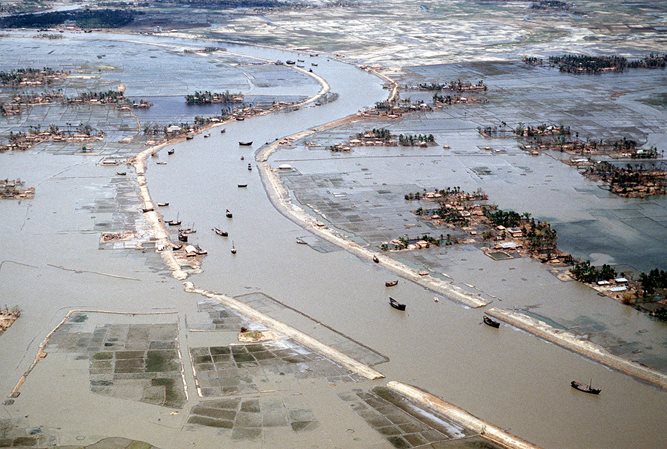After winding over the Bay of Bengal and up toward Bangladesh, the cyclone made landfall in the southerly Chittagong province before sweeping into the mountainous Hill Tracts. It left more than 138,000 dead in its wake and caused $1.7 billion worth of damage.
Bangladesh is no stranger to natural disasters. Cyclones are a yearly occurrence for the country’s 163 million citizens, many of whom live along the densely populated coastal flatlands. Climate change is worsening the situation, increasing both the severity and frequency of disasters, and threatening to displace one in every seven Bangladeshis by 2050.
Since 1991, however, Bangladesh has taken significant steps towards adapting to and mitigating the effects of cyclones, floods, and sea-level rise. The country is in the vanguard of those responding to climate change, despite its carbon emissions remaining well below the global average.
For a nation often cited as one of the most disaster-prone in the world, Bangladesh has gone to great lengths to implement comprehensive climate adaptation and risk reduction strategies at both the national and local levels.
.png)
The government has instituted numerous plans and policies over the last two decades to prepare for natural disasters, including the National Adaptation Plan of Action (NAPA) and the Bangladesh Climate Change Strategy and Action Plan (BCCSAP). They were among the first countries to establish institutions and funds focused solely on climate change, and have created cells within each ministry to “incentivize climate mainstreaming across sectors, policies, and plans”.
Consciously acknowledging that disaster management and wider development goals are intertwined, the government in 2018 instituted the ‘Bangladesh Delta Plan 2100’ – an all-encompassing strategy that tackles environmental sustainability, water security, economic development, and disaster management.
Although Bangladesh is still falling behind some of these targets, the country has made major progress towards reducing risk from disasters. According to the World Health Organisation, “Bangladesh has learnt how to adapt to recurrent cyclones and has succeeded in significantly reducing cyclone-related deaths. This has been achieved by modernizing early warning systems, developing shelters and evacuation plans, constructing coastal embankments, maintaining, and improving coastal forest cover and raising awareness at the community level.”
In 1970, the year Bangladesh was hit by the deadliest tropical cyclone ever recorded, the country had just 42 cyclone shelters. Today, there are more than 12,000 dispersed along Bangladesh’s sweeping coastline, serving nearly 5 million citizens.
From shelter-building to food security and early warning systems, extensive efforts to protect the population from the effects of climate-related disasters has so far been met with an equal measure of success. Owing to the nature of climate adaptation and risk reduction programmes, however, their best successes may only come to light in the most hazardous circumstances.
In 2007, Cyclone Sidr, the most powerful cyclone to strike Bangladesh since 1991, caused 3,406 fatalities – an enormous decrease in deaths compared with previous disasters. This downward trend has continued. In May 2020, Cyclone Amphan careened into the Ganges Delta with minimal loss of life - 26 fatalities were reported in Bangladesh.
Improved weather forecasting and a robust response plan enabled some 2.4 million people to be evacuated to safety before Cyclone Amphan made landfall. Early warning systems tailored to local needs (consisting of megaphones, social media, and radio) also proved integral in notifying at-risk populations.
Although the cyclone still incurred significant material damage, levelling more than 55,000 homes, the vast disparity in fatalities between 1991 and 2020 ought to be acknowledged as a victory for Bangladesh’s adaptation and risk reduction efforts.

Flooded villages and fields around a river in Bangladesh the day after the 1991 Bangladesh cyclone had struck the country.
Local and international NGOs, including RedR UK’s own Climate Change Adaptation and Disaster Risk Reduction (CCADRR) programme, also have a role to play in complementing Bangladesh’s climate policies and strategies. By focusing on capacity building, for example, CCADRR training can help prepare local communities for the risks that accompany natural disasters.
Should climate change continue unchecked, Bangladesh will come under greater strain from climate-related disasters in the coming decades. However, given the country’s improving trajectory of disaster preparedness and response, there is reason for hope. If progress continues at the current rate, Bangladesh will be able to meet each climate-related disaster more prepared than the last.